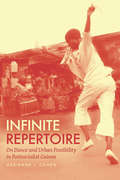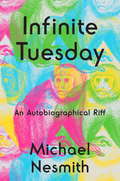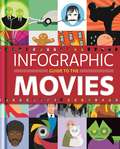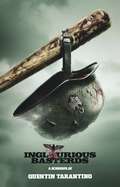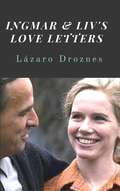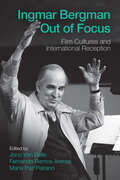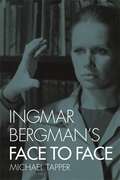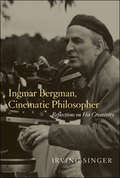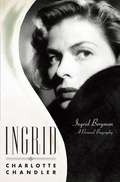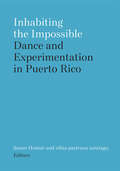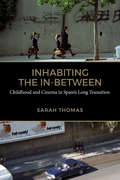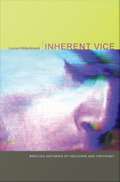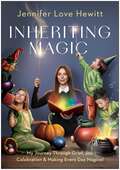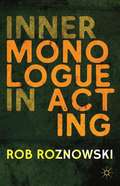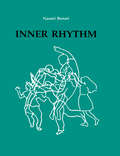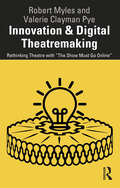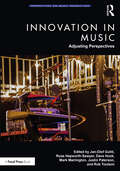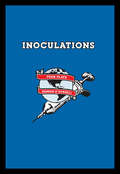- Table View
- List View
Infinite Repertoire: On Dance and Urban Possibility in Postsocialist Guinea
by Adrienne J. CohenIn Guinea’s capital city of Conakry, dance is everywhere. Most neighborhoods boast at least one dance troupe, and members of those troupes animate the city’s major rites of passage and social events. In Infinite Repertoire, Adrienne Cohen shows how dance became such a prominent—even infrastructural—feature of city life in Guinea, and tells a surprising story of the rise of creative practice under a political regime known for its authoritarianism and violent excesses. Guinea’s socialist state, which was in power from 1958 to 1984, used staged African dance or “ballet” strategically as a political tool, in part by tapping into indigenous conceptualizations of artisans as powerful figures capable of transforming the social fabric through their manipulation of vital energy. Far from dying with the socialist revolution, Guinean ballet continued to thrive in Conakry after economic liberalization in the 1980s, with its connection to transformative power retrofitted for a market economy and a rapidly expanding city. Infinite Repertoire follows young dancers and percussionists in Conakry as they invest in the present—using their bodies to build a creative urban environment and to perform and redefine social norms and political subjectivities passed down from the socialist generation before them. Cohen’s inventive ethnography weaves the political with the aesthetic, placing dance at the center of a story about dramatic political change and youthful resourcefulness in one of the least-studied cities on the African continent.
Infinite Repertoire: On Dance and Urban Possibility in Postsocialist Guinea
by Adrienne J. CohenIn Guinea’s capital city of Conakry, dance is everywhere. Most neighborhoods boast at least one dance troupe, and members of those troupes animate the city’s major rites of passage and social events. In Infinite Repertoire, Adrienne Cohen shows how dance became such a prominent—even infrastructural—feature of city life in Guinea, and tells a surprising story of the rise of creative practice under a political regime known for its authoritarianism and violent excesses. Guinea’s socialist state, which was in power from 1958 to 1984, used staged African dance or “ballet” strategically as a political tool, in part by tapping into indigenous conceptualizations of artisans as powerful figures capable of transforming the social fabric through their manipulation of vital energy. Far from dying with the socialist revolution, Guinean ballet continued to thrive in Conakry after economic liberalization in the 1980s, with its connection to transformative power retrofitted for a market economy and a rapidly expanding city. Infinite Repertoire follows young dancers and percussionists in Conakry as they invest in the present—using their bodies to build a creative urban environment and to perform and redefine social norms and political subjectivities passed down from the socialist generation before them. Cohen’s inventive ethnography weaves the political with the aesthetic, placing dance at the center of a story about dramatic political change and youthful resourcefulness in one of the least-studied cities on the African continent.
Infinite Tuesday: An Autobiographical Riff
by Michael NesmithMichael Nesmith’s eclectic, electric life spans his star-making role on The Monkees, his invention of the music video, and his critical contributions to movies, comedy, and the world of virtual reality. Above all, his is a seeker’s story, a pilgrimage in search of a set of principles to live by. That search took Nesmith from a childhood in Dallas, where his single mother Bette invented Liquid Paper, to the set of The Monkees in Los Angeles; to the heart of swinging London with John Lennon and Jimi Hendrix; and to an unexpected oasis of brilliance in the Santa Fe desert, where his friendships with Douglas Adams and Los Alamos scientists would point him toward the power of the infinite and the endless possibilities of human connection. This funny, thoughtful, self-aware book is a window onto an unexpected life, inflected at every turn by the surprising candor and absurdist humor of an American original. Opening Infinite Tuesday is like stepping into the world of Michael Nesmith, where something curious is always unfolding, and where riffs on everything from bands to dogs to the nature of reality make for an endlessly engaging journey.
Infinite Wonder: An Astronaut's Photographs from a Year in Space
by Scott KellyFrom the record-breaking astronaut, national hero, and best-selling author of Endurance, a breathtaking collection of photos documenting his journey on the International Space Station, the vastness of space, and the unparalleled beauty of our own home planet.One's perspective shifts when one lives for an entire year--as Commander Scott Kelly, and no other American astronaut in history, has--in the isolating, grueling, and utterly unforgiving vacuum of space. Kelly's photos prove that this perspective--from 250 miles above Earth-- while hard-won, is also almost unspeakably beautiful. A gift for photography helped make Kelly a social media sensation, and here his photos are collected alongside his own commentary, which set the images in their proper contexts, human and cosmic. Kelly captures sunsets, moonrises, the aurora borealis, and the luminous, hazy tapestry of the Milky Way. He presents snapshots of life and work on the International Space Station, from spacewalks to selfies. But above all--or floating amidst all--he takes the earth itself as his celestial muse. Here are hurricanes, wrinkled mountains, New York City shining like a galaxy--glorious photographs that are, in themselves, a passionate argument for the preservation of our planet in the face of climate change and environmental destruction.
Infographic Guide To The Movies (Infographic Guides)
by Karen Krizanovich"Naturally, there are all the types of information you'd expect to find in a book like this... but there's a whole lot more than that on offer here." - Starburst Magazine100 stunning, ingenious and absorbing movie infographics!Infographic Guide to Movies presents unique, witty and surprising facts about every film genre, from blockbuster, rom-com, horror, crime, sci-fi and action, to noir, zombie, nouvelle vague, slasher, erotica, world cinema and much, much more. Mixing cinematic fact with legend, it features infamous and often ludicrous tales of Hollywood, Bollywood, European cinema, underground and indie filmmaking.More than just a book of words, with graphs, Venn diagrams and charts, this book provides a unique overview of the movie world, boasting over 100 original artworks and illustrations and at-a-glance facts to amaze and astound readers-such as whether movies with a naked Helen Mirren or a naked Zach Galifiankis are likely to be more successful in Albania. There are graphics on every major movie genre and market in the world.Discover...Where in the world you're most likely to come across zombies.What the ultimate leading man would look like.Which actor was the best Bond.Who would win a fight between Rocky and Rambo.Judd Apatow's secret formula. How to kill Bruce Willis.How to get from Thomas Hardy to Tom Hardy.How much rom in a com makes the perfect rom-com. And so much more!
Information Inequality
by Herbert SchillerHerbert Schiller, long one of America's leading critics of the communications industry, here offers a salvo in the battle over information. In Information Inequality he explains how privatization and the corporate economy directly affect our most highly prized democratic institutions: schools and libraries, media, and political culture. A master media-watcher, Schiller presents a crisp and far-reaching indictment of the "data deprivation" corporate interests are inflicting on the social fabric.
Inglourious Basterds: A Screenplay
by Quentin TarantinoFrom the most original and beloved screenwriter of his generation, the complete Oscar-nominated screenplay of Quentin Tarantino's World War II epic Inglorious Basterds. From the brilliant writer/director behind the iconic films Pulp Fiction, Kill Bill, and Once Upon a Time in Hollywood, comes Tarantino's most ambitious movie: a World War II epic starring Brad Pitt and filmed on location in Germany and France. The action tale follows the parallel story of a guerrilla-like squad of American soldiers called "The Basterds" and the French Jewish teenage girl Shosanna who find themselves behind enemy Nazi lines during the German occupation. When the Inglourious Basterds encounter Shosanna at a propaganda screening at the movie house she runs, they conspire to launch an unexpected plot to end the war. Pitt plays Lieutenant Aldo Raine -- the leader of the Basterds. Raine is an illiterate hillbilly from the mountains of Tennessee who puts together a team of eight Jewish-American soldiers to hunt down the Nazis. Filled with Tarantino's trademark electric dialogue and thrilling action sequences, Inglourious Basterds is one of the most celebrated films of the twenty-first century.
Ingmar & Liv's Love Letters
by Lázaro Droznes Agasel LindawanThis dramatic fiction is an intimate, truthful look at the 42-year relationship between the legendary actress Liv Ullmann and the famous filmmaker Ingmar Bergman. The story of their bond is told through exchanged letters over the course of their lives, letters which their daughter ended up with. They filmed 12 movies together and shared their experiences in cinema, theatre, and writing. This work is an homage to two of the greatest artists of the 20th century, two marvelous beings, inseparable friends, and soulmates. Their relationship has been described by Bergman as a bond between two “painfully connected” individuals. It started as a spirited romance between a director and his actress, despite a 20-year age gap, and transformed into a beautiful friendship that lasted more than 40 years.
Ingmar Bergman Out of Focus: Film Cultures and International Reception
by Jono Van Belle, Fernando Ramos Arenas, and María Paz PeiranoDirector Ingmar Bergman occupies a central place in the history of modern cinema. Credited with igniting a cinematic revolution, his ability to produce work which resonated with audiences globally has brought scholarly attention to the impact of Bergman’s Swedish background on his oeuvre. Ingmar Bergman Out of Focus revises this question of Bergman’s “familiarity” to produce a more expansive understanding of Bergman’s cultural heritage. Considering the impact of Bergman’s films on film festival organizers, critics, academics, and audiences all over the world, this volume illuminates how Bergman’s film aesthetics simultaneously shaped modern culture and were themselves reshaped by the debates and concerns that preoccupied his viewers.
Ingmar Bergman's Face to Face (Treasury Of The Indic Sciences Ser.)
by Michael TapperThe 1976 premiere of Face to Face came at the height of director-screenwriter Ingmar Bergman's career. Prestigious awards and critical acclaim had made him into a leading name in European art cinema, yet today Face to Face is a largely overlooked and dismissed work.This book tells the story of its rise and fall. It presents a new portrait of Bergman as a political artist exploring a new medium with huge public impact: television. Inspired by Henrik Ibsen, feminism, and alternative psychotherapy, he made a series of portraits of the modern bourgeois family focusing on the plight of women; Face to Face followed in the tracks of The Lie (1970) and Scenes from a Marriage (1973). By his workbooks, engagement planners, and other archival material, we can trace his investigation into the heart of repressive family structures to eventually glimpse a way out. This volume culminates in an extensive study of the two-year process from the first outlines of the screenplay to the reception and aftermath of Face to Face. It thus offers a unique insight into Bergman's world, his ideas and artistry during a turbulent time in cinema history.
Ingmar Bergman, Cinematic Philosopher: Reflections on His Creativity (The Irving Singer Library)
by Irving SingerThe development of themes, motifs, and techniques in Bergman's films, from the first intimations in the early work to the consummate resolutions in the final movies.Known for their repeating motifs and signature tropes, the films of Ingmar Bergman also contain extensive variation and development. In these reflections on Bergman's artistry and thought, Irving Singer discerns distinctive themes in Bergman's filmmaking, from first intimations in the early work to consummate resolutions in the later movies. Singer demonstrates that while Bergman's output is not philosophy on celluloid, it attains an expressive and purely aesthetic truthfulness that can be considered philosophical in a broader sense. Through analysis of both narrative and filmic effects, Singer probes Bergman's mythmaking and his reliance upon the magic inherent in his cinematic techniques. Singer traces throughout the evolution of Bergman's ideas about life and death, and about the possibility of happiness and interpersonal love. In the overtly self-referential films that he wrote or directed (The Best Intentions, Fanny and Alexander, Sunday's Children) as well as the less obviously autobiographical ones (including Wild Strawberries, The Seventh Seal, and the triad that begins with Through a Glass Darkly) Bergman investigates problems in his existence and frequently reverts to childhood memories. In such movies as Smiles of a Summer Night, Scenes from a Marriage, and Saraband, Bergman draws upon his mature experience and depicts the troubled relationships between men who are often weak and women who are made to suffer by the damaged men with whom they live. In Persona, Cries and Whispers, and other works, his experiments with the camera are uniquely masterful. Inspecting the panorama of Bergman's art, Singer shows how the endless search for human contact motivates the content of his films and reflects Bergman's profound perspective on the world.
Ingmar Bergman: New Edition
by Barry Keith Grant Robin Wood Richard LippeAt a time when few reviewers and critics were taking the study of film seriously, Robin Wood released a careful and thoroughly cinematic commentary on Ingmar Bergman's films that demonstrated the potential of film analysis in a nascent scholarly field. The original Ingmar Bergman influenced a generation of film scholars and cineastes after its publication in 1969 and remains one of the most important volumes on the director. This new edition of Ingmar Bergman, edited by film scholar Barry Keith Grant, contains all of Wood's original text plus four later pieces on the director by Wood that were intended for a new volume that was not completed before Wood's death in 2010. In analyzing a selection of Bergman's films, Wood makes a compelling case for the logic of the filmmaker's development while still respecting and indicating the distinctiveness of his individual films. Wood's emphasis on questions of value (What makes a work important? How does it address our lives?) informed his entire career and serve as the basis for many of these chapters. In the added material for this new edition, Wood considers three important films Bergman made after the book was first published-Cries and Whispers, Fanny and Alexander, and From the Life of the Marionettes-and also includes significant reassessment of Persona. These pieces provocatively suggest the more political directions Wood might have taken had he been able to produce Ingmar Bergman Revisited, as he had planned to do before his death. In its day, Ingmar Bergman was one of the most important volumes on the Swedish director published in English, and it remains compelling today despite the multitude of books to appear on the director since. Film scholars and fans of Bergman's work will enjoy this updated volume.
Ingrid Bergman (Great Stars)
by David Thomson"Ingrid Bergman was far more than just a sweet, virtuous, ‘natural' Swedish girl—she was a dark sensualist over whom many men might go mad. Her very gaze delivered a climate of adult romantic expectation."Adored by millions for her luminous beauty and elegance, at the height of her career Bergman commanded a love that has hardly ever been matched, until her marriage fell apart and created an international scandal. Here the renowned film writer David Thomson gives his own unique take on a woman who was constantly driven by her passions and by her need to act, even if it meant sacrificing everything.
Ingrid: Ingrid Bergman, a Personal Biography (Applause Bks.)
by Charlotte ChandlerIngrid Bergman was one of the biggest and most glamorous stars in Hollywood -- until she became one of the most controversial, when an international scandal threatened to end her career. She had starred in several now-classic films: Casablanca, Spellbound, Notorious, Gaslight, and her co-stars included such Hollywood icons as Humphrey Bogart, Cary Grant, and Gregory Peck. In this insightful new biography, Charlotte Chandler draws on her extensive conversations with Bergman herself to describe what happened from Bergman's point of view, revealing a complex and fascinating woman who lived life intensely. Already a movie star in her native Sweden, Ingrid Bergman became an instant sensation for David O. Selznick in Hollywood and the number-one box-office star in the world. But the most dramatic event in her life took place off the screen when she made a film in Italy and began a passionate romance with her director, Roberto Rossellini. The scandal that followed left her exiled from America, ostracized by Hollywood, vilified in the press, denounced by clergy, censured in the U. S. Senate -- and separated from her young daughter. She was able to make films only with Rossellini. In the words of those who were involved, Chandler describes Bergman's life before, during, and after the scandal. Among those Chandler spoke with were Alfred Hitchcock, George Cukor, Sidney Lumet, Cary Grant, Gregory Peck, Greta Garbo, and Liv Ullmann. She spoke with Roberto Rossellini; their twin daughters, Isabella and Isotta Ingrid; Rossellini's son, Renzo; Ingrid's daughter Pia Lindstrom; and others who knew Ingrid well. This extraordinary access makes Ingrid: Ingrid Bergman, a Personal Biography the most perceptive and revealing book ever written about the charismatic Hollywood legend.
Inhabiting the Impossible: Dance and Experimentation in Puerto Rico (Studies in Dance: Theories and Practices)
by Susan Homar and nibia pastrana santiagoThis first-of-its-kind book brings together writing by artists and scholars to survey the lively field of Puerto Rican experimental dance across four decades. Originally published as Habitar lo Imposible, the translation in English features essays, artist statements, and interviews plus more than 100 photos of productions, programs, posters, and scores. Throughout, Inhabiting the Impossible provides fresh, invaluable perspectives on experimentation in dance as a sustained practice that has from the start deeply engaged issues of race, gender, sexuality, and politics. The book is also enhanced by a bibliographic section with detailed resources for further study.
Inhabiting the In-Between: Childhood and Cinema in Spain’s Long Transition (Toronto Iberic)
by Sarah ThomasAlthough children have proliferated in Spain’s cinema since its inception, nowhere are they privileged and complicated in quite the same way as in the films of the 1970s and early 1980s, a period of radical political and cultural change for the nation as it emerged from almost four decades of repressive dictatorship under the rule of General Francisco Franco. In Inhabiting the In-Between: Childhood and Cinema in Spain’s Long Transition, Sarah Thomas analyzes the cinematic child within this complex historical conjuncture of a nation looking back on decades of authoritarian rule and forward to an uncertain future. Examining films from several genres by four key directors of the Transition – Carlos Saura, Antonio Mercero, Víctor Erice, and Jaime de Armiñán – Inhabiting the In-Between explores how the child is represented as both subject and object, self and other, and consistently cast in a position between categories or binary poles. Its readings demonstrate how the cinematic child that materializes in this period is a fundamentally shifting, oscillating, ambivalent figure that points toward the impossibility of fully comprehending the historical past and the figure of the other, while inviting an ethical engagement with each.
Inherent Vice: Bootleg Histories of Videotape and Copyright
by Lucas HilderbrandIn an age of digital technology and renewed anxiety about media piracy, Inherent Vice revisits the recent analog past with an eye-opening exploration of the aesthetic and legal innovations of home video. Analog videotape was introduced to consumers as a blank format, essentially as a bootleg technology, for recording television without permission. The studios initially resisted VCRs and began legal action to oppose their marketing. In turn, U. S. courts controversially reinterpreted copyright law to protect users' right to record, while content owners eventually developed ways to exploit the video market. Lucas Hilderbrand shows how videotape and fair use offer essential lessons relevant to contemporary progressive media policy. Videotape not only radically changed how audiences accessed the content they wanted and loved but also altered how they watched it. Hilderbrand develops an aesthetic theory of analog video, an "aesthetics of access" most boldly embodied by bootleg videos. He contends that the medium specificity of videotape becomes most apparent through repeated duplication, wear, and technical failure; video's visible and audible degeneration signals its uses for legal transgressions and illicit pleasures. Bringing formal and cultural analysis into dialogue with industrial history and case law, Hilderbrand examines four decades of often overlooked histories of video recording, including the first network news archive, the underground circulation of Superstar: The Karen Carpenter Story, a feminist tape-sharing network, and the phenomenally popular website YouTube. This book reveals the creative uses of videotape that have made essential content more accessible and expanded our understanding of copyright law. It is a politically provocative, unabashedly nostalgic ode to analog.
Inheriting Magic: My Journey Through Grief, Joy, Celebration, and Making Every Day Magical
by Jennifer Love HewittWhen she lost her mother to cancer, everything changed for Jennifer Love Hewitt. In the pages of Inheriting Magic, she recounts her journey, sharing memories, photographs, recipes, and the magic-making ethos of a self-proclaimed &“Holiday Junkie.&” A heartfelt, candid chronicle that charts a course from sorrow to celebration, this unique memoir includes: • Never-seen-before family photos and vintage snapshots • Jennifer&’s favorite recipes, from her grandmother&’s chicken and dumplings to her husband&’s holiday cocktail • An explosion of festive plans, including images, sure to inspire your decorating plans for Halloween, Christmas, Easter, birthdays, and a whole year&’s worth of holidays • Foolproof strategies for adding magic to your family&’s everyday routine, such as moon water, baskets of joy, glowing dinners, and more Inheriting Magic is about how grief, being a mom of three, having a deep love for party planning, and being passionate about the holidays turned what could have been an ordinary life into something enchanting. Through it, Jennifer inspires all readers to add more love, light, and the making of core memories into their everyday lives.
Ink-Stained Hollywood: The Triumph of American Cinema’s Trade Press
by Eric HoytA free open access ebook is available upon publication. Learn more at www.luminosoa.org. For the first half of the twentieth century, no American industry boasted a more motley and prolific trade press than the movie business—a cutthroat landscape that set the stage for battle by ink. In 1930, Martin Quigley, publisher of Exhibitors Herald, conspired with Hollywood studios to eliminate all competing trade papers, yet this attempt and each one thereafter collapsed. Exploring the communities of exhibitors and creative workers that constituted key subscribers, Ink-Stained Hollywood tells the story of how a heterogeneous trade press triumphed by appealing to the foundational aspects of industry culture—taste, vanity, partisanship, and exclusivity. In captivating detail, Eric Hoyt chronicles the histories of well-known trade papers (Variety, Motion Picture Herald) alongside important yet forgotten publications (Film Spectator, Film Mercury, and Camera!), and challenges the canon of film periodicals, offering new interpretative frameworks for understanding print journalism’s relationship with the motion picture industry and its continued impact on creative industries today.
Inner Monologue In Acting
by Rob RoznowskiWhat should an actor be thinking onstage? This overlooked, important question is the crux of this new book that combines psychological theory, numerous practical exercises, and a thorough and wide-reaching examination of inner monologue in various forms including film, musical theatre, and comedy. The Inner Monologue is that 'stream of consciousness' or 'inner voice' that constantly echoes in your head. This revolutionary new book tames and harnesses that voice to be used as a powerful tool in acting. Written in an accessible tone, the book assists actors, directors and educators in their quest for deeper more thoughtful acting and is a perfect supplement to traditional actor training.
Inner Rhythm: Dance Training for the Deaf
by Naomi BenariIn Inner Rhythm, Naomi Benari provides exciting new ways to teach dance to the profoundly deaf by showing: methods and games she devised with children to heighten their awareness of rhythm, music and the breath inherent in every dance movement; how the knowledge of music is the basis for dance teaching and how this knowledge can enhance the raining of hearing dancers; opportunities for children to express their unarticulated feelings and thoughts; how children can learn to socialize and to explore the world in which they live; and how to teach dance to the profoundly deaf in a vareity of schools and settings.
Inner Sanctum Mysteries: Behind the Creaking Door
by Martin GramsInner Sanctum Mystery is considered by many as the founding father of radio horrors. Known for its signature opening creaking door, Raymond the host invited listeners in for a weekly half-hour fright fest of murder and madness. Werewolves, vampires, creeping vines, walking corpses, evening storms, haunted houses, black cats, vengeful ancestors, and even ghosts roamed the airwaves. For eleven seasons this horror program frightened listeners and today, the program remains one of the best-known radio horrors of the Twentieth Century. Horror stars Boris Karloff, Peter Lorre and Lon Chaney, Jr. Were the star figures in these classics, along with Frank Sinatra, Agnes Moorehead, Judith Evelyn, Ralph Bellamy, Donald Buka, and many others. This book documents the history of this horror program, including an episode guide for the radio series and television programs, documentation of the horror movies, and a listing of the Simon & Schuster mystery novels. Years of research and a wealth of information can be found within these pages-making this book a "must have" for every old-time radio fan.
Innovation & Digital Theatremaking: Rethinking Theatre with “The Show Must Go Online”
by Valerie Clayman Pye Robert MylesInnovation & Digital Theatremaking introduces a blueprint for how to think differently about Theatre, how to respond creatively in uncertainty, and how to wield whatever resources are available to create new work in new ways. In 2020, the COVID-19 pandemic had a colossal impact on theatre across the world. At a time when even the wealthiest and best-supported theatre companies in the world ceased all operations and shuttered their stages, the theatre company The Show Must Go Online (TSMGO) forged its way into a new frontier: the highly accessible digital landscape of online performance. In this book, TSMGO creator Robert Myles and Valerie Clayman Pye explore the success of TSMGO from a practical standpoint, offering insights and strategies that can help theatremakers at every level respond proactively to the future of Theatre in the digital era. Each chapter addresses a different aspect of the creative process and concludes with take-homes so readers can learn how to innovate rapidly, undertake research and development in order to create their own models, and cultivate their own theatrical communities. Written for theatremakers, directors, producers, and creatives of all levels of experience, this book will help readers to think critically and creatively about theatre and theatre pedagogues to understand how to train their students for the theatre of the future.
Innovation in Music: Adjusting Perspectives (Perspectives on Music Production)
by Russ Hepworth-Sawyer Mark Marrington Justin Paterson Rob Toulson Jan-Olof Gullö Dave HookInnovation in Music: Adjusting Perspectives brings together cutting-edge research on new innovations in the field of music production, technology, performance, and business. With contributions from a host of well-respected researchers and practitioners, this volume provides crucial coverage on the relationship between innovation and rebellion.Including chapters on generative AI, gender equality, live music, quantisation, and composition, this book is recommended reading for music industry researchers working in a range of fields, as well as professionals interested in industry innovations.
Inoculations: Four Plays
by Darren O'DonnellThese four plays - 'White Mice', 'Who Shot Jacques Lacan?', 'Radio Rooster Says That's Bad' and 'Over' - written by Darren O'Donnell for his theatre company, Mammalian Diving Reflex, will challenge your politics, your ontology and everything you hold to be safe, stable and sacrosanct.
